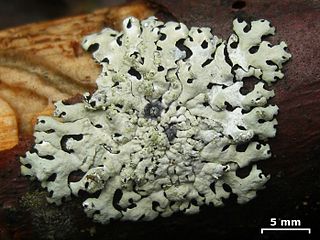
The Parmeliaceae is a large and diverse family of Lecanoromycetes. With over 2700 species in 71 genera, it is the largest family of lichen-forming fungi. The most speciose genera in the family are the well-known groups: Xanthoparmelia, Usnea, Parmotrema, and Hypotrachyna.
Cetreliopsis is a genus of four species of lichens in the family Parmeliaceae.

Hypotrachyna is a genus of lichenized fungi within the family Parmeliaceae. According to the Dictionary of the Fungi, the widespread genus contains about 198 species. Hypotrachyna was circumscribed by American lichenologist Mason Ellsworth Hale Jr in 1974.
Hypotrachyna oprah is a species of foliose lichen in the family Parmeliaceae. Found in the United States in North Carolina, Alabama, and Florida, it was described as new to science in 2019 by lichenologists James Lendemer and Jessica Allen. It was named in honor of Oprah Winfrey. It contains the secondary chemical lichexanthone.
Remototrachyna is a genus of foliose lichens in the large family Parmeliaceae. It was separated from the genus Hypotrachyna based on the structure of the excipulum and genetic differences.
Hypotrachyna vainioi is a species of foliose lichen in the family Parmeliaceae. It is found in Brazil.
Hypotrachyna is a species of foliose lichen in the family Parmeliaceae. Originally described from specimens collected in Venezuela, it is found in mountains throughout the Neotropics, where it grows on pine and hardwood bark.
Hypotrachyna ahtiana is a species of foliose lichen in the family Parmeliaceae. It is known only from the type locality in Venezuela, where it was collected in the Guyana Shield at an elevation of 1,950 m (6,400 ft). It is named to honour Finnish lichenologist Teuvo Ahti.
Hypotrachyna alectorialiorum is a species of foliose lichen in the family Parmeliaceae. It is known only from the type locality in Minas Gerais, Brazil, where it was found growing on soil over rock, at an elevation of 1,200 m (3,900 ft). The specific epithet refers to the presence of the secondary chemicals alectorialic acid and hypoalectorialic acid.
Hypotrachyna andensis is a species of foliose lichen in the family Parmeliaceae. It is known to occur in the Neotropics and in Papua New Guinea.
Hypotrachyna anzeana is a species of foliose lichen in the family Parmeliaceae. It occurs in the Andes of Colombia and Bolivia, where it grows over moss cushions on acidic rocks at an elevation of 3,500–3,900 m (11,500–12,800 ft). The specific epithet honours the collector of the type specimen, the environmental biologist Rafael Anze Martin.
Hypotrachyna aspera is a species of foliose lichen in the family Parmeliaceae. It occurs in the mountains of Minas Gerais and Paraná, where it grows on tree bark in humid forests at an elevation of about 1,100 m (3,600 ft).
Hypotrachyna bogotensis is a species of foliose lichen in the family Parmeliaceae. It was first described scientifically by Finnish lichenologist Edvard August Vainio. Mason Hale transferred it to the genus Hypotrachyna in 1975. It is a common species in the high mountains of the Central America and the northern Andes. It has also been recorded from southern Chile and from Gough Island.
Hypotrachyna boquetensis is a species of foliose lichen in the family Parmeliaceae. It was first described scientifically by lichenologist Mason Hale as a member of the genus Parmelia; he transferred it to the genus Hypotrachyna a year later. It is found in the mountains of Central and northern South America, where it grows on hardwood trunks and branches at elevations of 1,400–2,800 m (4,600–9,200 ft). It has also been recorded from India.
Hypotrachyna brevidactylata is a species of foliose lichen in the family Parmeliaceae. It is an uncommon species that occurs in the mountains of Costa Rica, and in the Andes of Bolivia and Ecuador, at elevations of 2,500–3,600 m (8,200–11,800 ft). Its specific epithet refers to its resemblance to Hypotrachyna brevispora, and the presence of laminal dactyls.
Hypotrachyna brevirhiza is a species of foliose lichen in the family Parmeliaceae. First described as a species of Parmelia by Syo Kurokawa in 1964, Mason Hale transferred it to the genus Hypotrachyna in 1975. The lichen is widespread in Central American Mountains and in the Andes at elevations of 2,700–4,300 m (8,900–14,100 ft), where it grows as an epiphyte on exposed trees and shrubs. It also occurs in southern South America, Africa, India, Indonesia, Papua New Guinea, Macquarie Island, and the Pacific.
Hypotrachyna brueggeri is a species of foliose lichen in the family Parmeliaceae. Described as a new species in 2002, it is known only from the type locality in southeastern Brazil, where it was collected at elevations of 1,000–1,400 m (3,300–4,600 ft).

Hypotrachyna osseoalba, commonly known as the grainy loop lichen, is a species of foliose lichen in the family Parmeliaceae. It is widely distributed in subtropical and temperate areas of the world. Characteristic features of the lichen include the pustules in its cortex, the somewhat linear shape of the lobes comprising the thallus, and the branched rhizines.
Hypotrachyna mcmulliniana is a species of foliose lichen in the family Parmeliaceae. It has a blue-grey thallus about 3-10 cm wide, with lobes 1.0–4.0 mm wide, and isdia without hairs.
Hypotrachyna kauffmaniana is a species of blue-gray to gray foliose lichen in the family Parmeliaceae. This species can only be located in eastern North America along the Appalachian Mountains, commonly found in Georgia, South Carolina, North Carolina, and Tennessee. The habitat of H. kauffmaniana is typically mid-elevation forests on both hardwood and conifer tree branches/trunks within the southern Appalachians. On rare occasions, this species can be found growing on non-calcareous rocks. H. kauffmaniana gathered its name in honor of Gary Kauffman, a botanist for the National Forest Service. H. kauffmaniana can be commonly confused alongside Hypotrachyna showmanii, but is distinguishable due to the former producing different levels of gyrophoric acid as well as possessing slightly different morphological properties.

